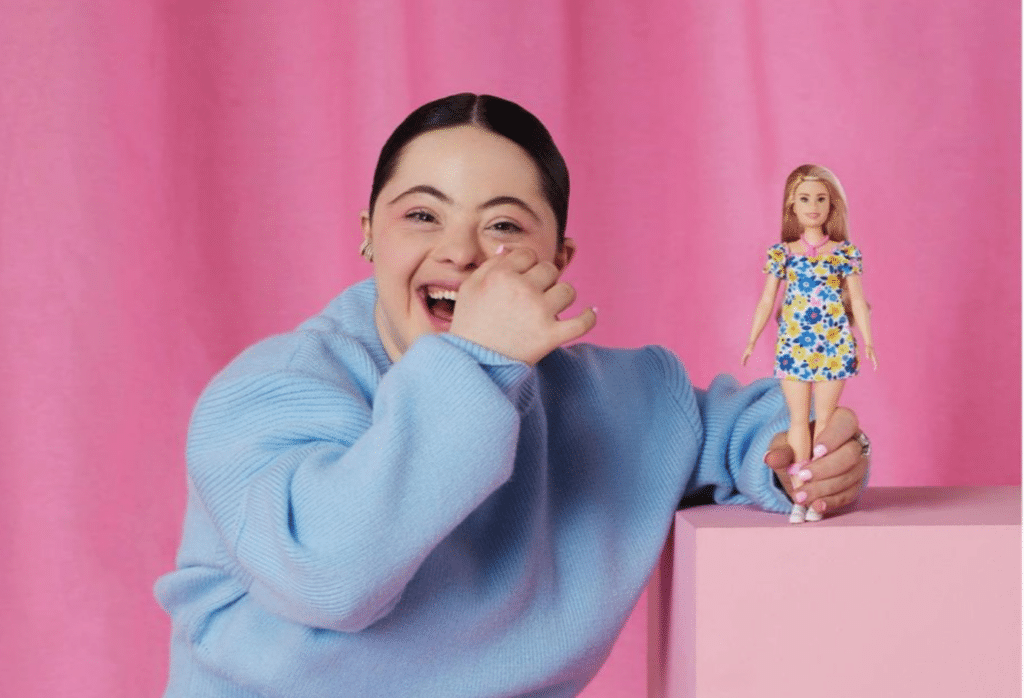Barbie makers Mattel have announced a new doll — a Barbie with Down syndrome.
In their efforts to fulfil the company’s original mission for “all children to see themselves in Barbie”, the latest doll signals Mattel’s diversifying range, which has included wheelchair-user Barbies, Barbies with a hearing aid, and Barbies with a prosthetic limb.
According to Mattel’s announcement on the new doll, the company partnered with the US National Down Syndrome Society (NDSS) to design a doll that accurately portrayed a person with Down syndrome.
“Meaningful symbols are incorporated throughout her outfit, like butterflies — which are a symbol of Down syndrome — and the blue and yellow colour palette, which represents Down syndrome awareness,” the product description reads.
The doll is shorter than the original doll and has a longer torso, while its face is rounder with smaller ears. Other characters that are commonly seen in women who have the genetic condition include a flat nasal bridge and almond-shaped eyes — both of which are represented on the doll.
The new doll wears a pink pendant necklace with three arrows — representing the third 21st chromosome that persons with Down syndrome have. She also has a pair of pink ankle foot orthoses (AFOs) as some individuals with Down’s syndrome use orthotics to support their feet and ankles, and her white sneakers have a zipper detail so that children can slip them on and off.
Mattel’s executive vice president and global head of Barbie & Dolls, Lisa McKnight said she hoped the new doll would help “teach understanding and build a greater sense of empathy, leading to a more accepting world,” and “counter social stigma through play.”
“Our goal is to enable all children to see themselves in Barbie, while also encouraging children to play with dolls who do not look like themselves,” McKnight said in a statement.
“Doll play outside of a child’s own lived experience can teach understanding and build a greater sense of empathy…. We are proud to introduce a Barbie doll with Down syndrome to better reflect the world around us and further our commitment to celebrating inclusion through play.”
Kandi Pickard, NDSS president and CEO, described the collaboration between her organisation with Mattel as “an honour.”
“This means so much for our community, who for the first time, can play with a Barbie doll that looks like them,” Pickard said.
“We should never underestimate the power of representation. It is a huge step forward for inclusion and a moment that we are celebrating.”
21-year old British model Ellie Goldstein, who has Down syndrome, said she was “overwhelmed” when she saw the doll.
On Instagram, Goldstein wrote: “I am so thrilled there are now Barbie dolls with Down’s syndrome. When I saw the doll I felt so emotional, and proud.”
“It means a lot to me that children will be able to play with the doll and learn that everyone is different. I am proud that Barbie chose me to show the dolls to the world. Diversity is important as people need to see more people like me out there in the world and not be hidden away, Barbie will help make this happen.”
Goldstein is a global advocate for the rights of people with Down’s syndrome and has worked with huge brands including Adidas, Victoria’s Secret and the U.K learning disability charity Mencap.
She also graced the cover of the latest edition of British Vogue. In an interview for the magazine, Goldstein said it was “100 per cent” important that we see models with disabilities represented in fashion campaigns.
“It has started to change, but it still has a long way to go,” she said. “Brands shouldn’t be afraid to [cast] people like me; I know I bring happiness with my work and make people smile. Everyone should be seen and not hidden. [People with disabilities] can be easily overlooked and written off. We are the same as everyone else, sometimes a bit slower in things, but we need to be given a chance.”
Mattel’s latest doll comes as big toy brands have made similar moves in the past few years to make their products more inclusive.
Lego released its first wheelchair user mini-figure in 2016 after a campaign by the UK-based #ToyLikeMe group called for more inclusive representation.
That same year, Mattel released Curvy Barbie, Barbies with vitiligo and Barbies of different ethnicities.



